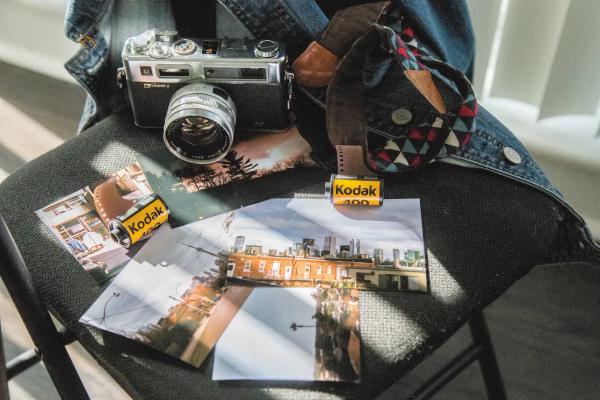
How to set
a pricing strategy
for your photography
studio business
Pricing is an important aspect of your photography studio business. Many photography business owners don't have a proper pricing strategy for their photography business.
You certainly don't want to undercut your pricing, and it's never a good idea to overcharge. It's always a good idea to charge exactly what you are worth. But the million-dollar question is how to figure out exactly what your photography is worth.
That's what we're going to discuss today. We will discuss the key elements to create a pricing strategy for a photography business.
1. Have a business plan
The key to success in any business endeavor is to have a proper business plan. This is where many photographers tend to falter because they think all they require to make money with photography business is the skill to take photos. They often overlook the business side of things, including having a proper business plan.
A photography studio business can deal with commercial, personal, or social photography. Commercial photography is the art of taking photos of products, and photographers in this genre tend to use a tad more equipment than social or personal photographers do.
On the other hand, social photographers use less equipment and travel more than commercial photographers who work primarily from their studio establishments.
That said, a social/personal photographer too could have a studio setup, but their equipment and cost of running a business are different than commercial photographers. So they will tend to charge differently.
Depending on the photography you do, you've to find out the costs of running a business and your fixed costs like depreciation and equipment replacement—more on that in the following segment.

2. Fixed and flexible costs
A pricing plan for a photo business must take into account the various costs. Photographers working in different genres of photography tend to have different costs associated with their operations.
Though they may seem to run a similar infrastructure, the costs should be equal. In reality, no two businesses are similar, and therefore no two businesses have the same set of costs.
Two photographers might be working in the same genre –commercial photography, but they may be targeting two different sub-genres.
Because of this, their gear investment may differ, their need for production assistants may vary, and their need to travel may differ. All this add up to two different sets of costs and, therefore, different pricing strategy.
No matter the genre and the infrastructure as a business owner, you must look at things pragmatically. You're running a business, and that business can only survive if it's making a profit. The simple equation for profit is revenue minus costs, so figuring out your costs is vital to get started.
Costs can be divided into fixed and flexible or variable costs. Fixed costs denote costs that don't change depending on the nature of the assignment. These could include the rent of the studio space, fixed salaries of your assistants, depreciation on your equipment, and so on.
Variable costs denote costs that vary according to the nature of an assignment. So, let's say a shoot lasts two days and requires most of your studio lights.
Your power bill will be more than what it would be if the shoot were to last for only half a day; if you hire temporary assistants for a shoot, that's also an example of variable costs. Having to travel for an assignment also means additional variable costs.
When calculating the total cost, you incur for an assignment, you've to factor in the variable costs and proportionate fixed costs.
3. Discounts & promotions
As a business owner, you must target how much revenue you're planning to generate in a year. It's the total of your variable costs + your fixed costs + your profit + taxes.
The profit amount can be interchangeable with net revenue, which is your share of the business's income after meeting all business expenses and liabilities.
If you know in your mind exactly what magic number you've to meet by the end of the year, you can play around with the pricing and offer discounts and promotions to your clients.
Discounts and promotional pricing will have two major benefits – first, they will drive more traffic/customers, and two, convert more sales. If a marginal 10% discount on your list prices increases your sales by 15-20%, it's a win-win situation to make money with the photography business.
The best thing about this is that the photographer doesn't require a computer to access his appointments. He can log in to the system and access all his appointments using his phone.

4. Outsource tasks like scheduling
One way to construct a profitable pricing strategy for a photography business is to automate as much of the business process as possible. Let's take the example of scheduling appointments.
Usually, a small business owner has to do this task independently. Free scheduling software such as Vev can help save a lot of time and energy for the business owner by automating the entire scheduling process.
Clients can log on to the scheduling software, select the dates when the photographer is available and book the dates. An automated e-mail goes out to the photographer informing him about the new booking.
The system works 24/7, even when the photographer is asleep or busy on a different project.
The best thing about this is that the photographer doesn't require a computer to access his appointments. He can log in to the system and access all his appointments using his phone.
“Save a lot of time and energy for the business owner by automating the entire scheduling process. ”
5. Doing research
It's easy to make money with photography business, but the preparations, the planning process, and cost analysis take time and effort. It's not always easy because a photographer may not have all the information to make an accurate cost analysis.
If a precise cost analysis is not possible, a pricing strategy for a photography business cannot be done. There is, however, a solution – researching.
As a photography business owner, you can research and figure out the pricing strategy of other businesses that are already operating in a similar line as yours.
Figure out how much they're charging for their photography packages. Make a reverse cost analysis to determine the profit percentage and use that as a basis to calculate your pricing strategy.

6. Run promotions
Promotional activities are a great way to build a brand and let the world know you're offering photography services. There are multiple facets to running promotional activities for a photography business.
Most photographers feel that the only qualifying aspect to professional success is to be good at what you do best – i.e., photography. But professional success depends on more than just being good at photography.
There are hundreds and thousands of photographers who have an excellent body of work, but they struggle to get great business. The reason is they do not tap into the power of marketing.
Marketing is a huge component of achieving business success; unfortunately, not many people are good at that.
Here's what you can do to change all that – start a blog, promote on social media, advertise in local papers and magazines, collaborate with other professionals in the photography segment, and attend photography events.
“Start a blog, promote on social media, advertise in local papers and magazines, collaborate with other professionals, and attend events. ”
7. Start a photography blog
A blog is a great way to showcase your knowledge and expertise to potential clients. You can blog about anything within the domain of photography. You can share anecdotes from your career, how you started as a photographer, and talk about your life as a photographer.
On the other side, you can also talk about the technicalities of photography. That would establish you as an expert photographer who knows what he is doing.

8. Charge for extras
Depending on the genre of photography you are working in, you can always charge extra for extra services or products sold to your clients.
As a social or personal photographer such as one who shoots weddings, events, birthdays, and parties, you can always charge extra for extra hours of work, extra prints, framed prints, and albums.
Social photographers routinely upsell and cross-sell their products and services, which commercial photographers don't get to do.
Ready to come up with your own pricing strategy?
The pricing strategy for your business will depend on the exact nature of the costs of your business. No two businesses have identical costs, and therefore no two businesses can employ the same pricing strategy.
However, companies in a similar trade line tend to have a comparable cost structure, which gives you an idea of how to build your pricing strategy.
Still, it's dependent heavily on the exact nature of your business. Hopefully, the above pointers will help you to make an informed decision about your pricing strategy.
And don't forget to try out Vev's free appointment scheduling software for photographers. Feel free to let us know what you think.
Frequently asked questions
How important is the pricing strategy for a photography business?
The profitability of a photography business is directly linked to its pricing strategy. If the pricing strategy is incorrect, profitability will suffer, and it will be challenging to run the business.
Is it possible to make an accurate pricing strategy for a photography business?
The process of making a pricing strategy is always an educated guess. The process is difficult because not all costs are easy to be estimated. Nevertheless, historical data can be used to make a reasonable estimate.
Create your own page in 3 simple steps
Describe your business
Vev will create a custom page for you.
Get started
Click around to see how Vev works.
Customize your page
Add photos, descriptions and set your pricing.



